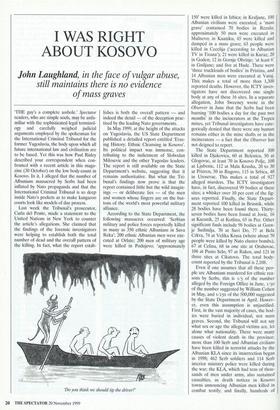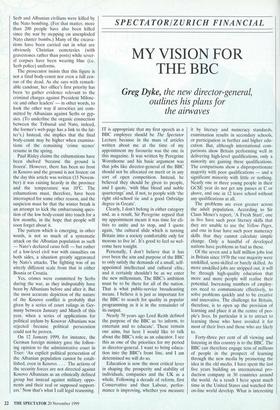I WAS RIGHT ABOUT KOSOVO
John Laughland, in the face of vulgar abuse, still maintains there is no evidence of mass graves
'THE guy's a complete asshole.' Spectator readers, who are simple souls, may be unfa- miliar with the sophisticated legal terminol- ogy and carefully weighed judicial arguments employed by the spokesman for the International Criminal Tribunal for the former Yugoslavia, the body upon which all future international law and civilisation are to be based. Yet this was how Paul Risley described your correspondent when con- fronted with a recent article in this maga- zine (30 October) on the low body-count in Kosovo. In it, I alleged that the number of Albanians massacred by Serbs had been inflated by Nato propaganda and that the International Criminal Tribunal is so deep inside Nato's pockets as to make kangaroo courts look like models of due process.
Last week the Tribunal's prosecutor, Carla del Ponte, made a statement to the United Nations in New York to counter the article's allegations. She claimed that the findings of the forensic investigators were helping to establish both the total number of dead and the overall pattern of the killing. In fact, what the report estab- lishes is both the overall pattern — and indeed the detail — of the deception prac- tised by the leading Nato governments.
In May 1999, at the height of the attacks on Yugoslavia, the US State Department published a detailed report entitled 'Eras- ing History: Ethnic Cleansing in Kosovo'. Its political impact was immense, con- tributing to the indictment of Slobodan Milosevic and the other Yugoslav leaders. The report is still available on the State Department's website, suggesting that it remains authoritative. But what the Tri- bunal's findings now prove is that the report contained little but the wild imagin- ings — or deliberate lies — of the men and women whose fingers are on the but- tons of the world's most powerful military alliance.
According to the State Department, the following massacres occurred: 'Serbian military and police forces reportedly killed as many as 350 ethnic Albanians in Suva Reka'; 200 ethnic Albanian men were exe- cuted at Orlate; 200 men of military age were killed in Podujevo; 'approximately 'Do you think we should tip the driver?'
150' were killed in Izbica; in Kraljane, 100 Albanian civilians were executed; a 'mass grave' contained 70 bodies in Rezala; approximately 50 men were executed in Malisevo; in Kaaniku, 45 were killed and dumped in a mass grave; 63 people were killed in Cecelija ('according to Albanian TV in Tirana'); 21 were killed in Kuraz; 20 in Goden; 12 in Gornje Obrinje; 'at least 6' in Gniljane; and five at Hade. There were 'three truckloads of bodies' in Pristine, and 14 Albanian men were executed at Vataj. This makes a total of more than 1,300 reported deaths. However, the ICTY inves- tigators have not discovered one single body at any of these 16 sites. In a separate allegation, John Sweeney wrote in the Observer in June that the Serbs had been burning '100 bodies a day for the past two months' in the incinerators at the Trepca mines, yet Tribunal investigators have cate- gorically denied that there were any human remains either in the mine shafts or in the incinerators — a fact that the Observer has not deigned to report.
The State Department reported 300 killed in Djakovica, 60 at Belenica, 50 at Glogovac, at least 70 in Kosovo Polje, 100 at Ljubenic, 112 at Mala Krusha, 20 to 30 at Prizren, 50 in Rugovo, 115 in Srbica, 40 in Urosevac. This makes a total of 927 alleged murders. The ICTY investigators have, in fact, discovered 99 bodies at these sites; a whisker over 10 per cent of the fig- ures reported. Finally, the State Depart- ment reported 100 killed in Brusnik, while 28 bodies have been found there. Thirty- seven bodies have been found at Jovic, 16 at Kacanik, 25 at Kotlina, 65 in Pec. Other significant finds include 98 bodies at Gorn- je Sudimlja, 70 at Suvi Do, 77 at Bela Crkva, 74 at Velika Krusa (where about 70 people were killed by Nato cluster bombs), 67 at Celina, 68 in one site at Orahovac, 106 at Pusto Selo, 97 at Rakos, and 121 in three sites at Cikatovo. The total body- count reported by the Tribunal is 2,108.
Even if one assumes that all these peo- ple are Albanians murdered for ethnic rea- sons by Serbs, this is 1/5 of the number alleged by the Foreign Office in June, 1/50 of the number suggested by William Cohen in May, and 1/250 of the 500,000 suggested by the State Department in April. Howev- er, even this assumption is unjustified. First, in the vast majority of cases, the bod- ies were buried in individual, not mass graves. Second, the Tribunal will not say what sex or age the alleged victims are, let alone what nationality. There were many causes of violent death in the province: more than 100 Serb and Albanian civilians have been killed in terrorist attacks by the Albanian KLA since its insurrection began in 1998; 462 Serb soldiers and 114 Serb interior ministry police were killed during the war; the KLA, which had tens of thou- sands of men under arms, also sustained casualties, as death notices in Kosovo towns announcing Albanian men killed in combat testify; and finally, hundreds of Serb and Albanian civilians were killed by the Nato bombing. (For that matter, more than 200 people have also been killed since the war by stepping on unexploded Nato cluster bombs.) Many of the excava- tions have been carried out in what are obviously Christian cemeteries (with gravestones rather than posts) while sever- al corpses have been wearing blue (i.e. Serb police) uniforms.
The prosecutor insists that this figure is not a final body-count nor even a full cen- sus of the dead. As she says with remark- able candour, her office's first priority has been to gather evidence relevant to the criminal charges against President Milose- vic and other leaders' — in other words, to look the other way if atrocities are com- mitted by Albanians against Serbs or gyp- sies. (To underline the organic connection between the Tribunal and Nato, indeed, the former's web-page has a link to the lat- ter's.) Instead, she implies that the final body-count may be higher when examina- tions of the remaining 'crime scenes' resume in the spring.
Paul Risley claims the exhumations have been shelved 'because the ground is frozen'. However, there has been no frost in Kosovo and the ground is not frozen: on the day this article was written (15 Novem- ber) it was raining heavily in the province and the temperature was 10°C. The exhumations must, therefore, have been interrupted for some other reason, and the suspicion must be that the winter break is an attempt to kick the embarrassing ques- tion of the low body-count into touch for a few months, in the hope that people will soon forget about it.
The pattern which is emerging, in other words, is not so much of a systematic attack on the Albanian population as such — Nato's declared casus belli — but rather of a low-level civil war with casualties on both sides, a situation greatly aggravated by Nato's attacks. The fighting was of an utterly different scale from that in either Bosnia or Croatia.
Yes, crimes were committed by Serbs during the war, as they indisputably have been by Albanians before and after it. But the most accurate depiction of the nature of the Kosovo conflict is probably that given by a series of court rulings in Ger- many between January and March of this year, when a series of applications for political asylum by Kosovar Albanians was rejected because political persecution could not be proven.
On 12 January 1999, for instance, the German foreign ministry gave the follow- ing opinion to the administrative court in Trier: 'An explicit political persecution of the Albanian population cannot be estab- lished, even in Kosovo.... The actions of the security forces are not directed against Kosovo Albanians as an ethnically defined group but instead against military oppo- nents and their real or supposed support- ers.' Now that's what I call legal reasoning.



























































































 Previous page
Previous page